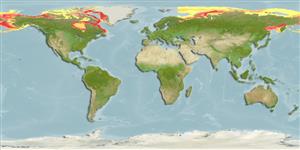>
Perciformes/Cottoidei (Sculpins) >
Agonidae (Poachers) > Anoplagoninae
Etymology: Aspidophoroides: Greek, aspidos, shield + Latin, fero = to carry (Ref. 45335).
Eponymy: Christian Søren Marcus Olrik (1815–1870) was a Danish Greenlander who was a zoologist, botanist, teacher and Inspector of North Greenland (where the species occurs). [...] (Ref. 128868), visit book page.
More on author: Lütken.
Environment: milieu / climate zone / profondeur / distribution range
Écologie
marin; saumâtre démersal; profondeur 0 - 632 m (Ref. 117245). Polar; 83°N - 51°N, 33°E - 45°W (Ref. 117245)
Arctic to Northwest Atlantic and Northwest to Northeast Pacific: Hudson Bay and Labrador in Canada and Greenland. Also in the Barents Sea, Kara Sea, White Sea and Siberia (Ref. 4700); Chukchi Sea, Bering Strait, Bering Sea and Anadyr Gulf (Ref. 6876).
Taille / Poids / Âge
Maturité: Lm ? range ? - ? cm
Max length : 8.6 cm TL mâle / non sexé; (Ref. 4700)
Description synthétique
Clés d'identification | Morphologie | Morphométrie
Épines dorsales (Total) : 0; Rayons mous dorsaux (Total) : 5 - 7; Épines anales: 0; Rayons mous anaux: 5 - 7. Caudal fin rounded. Upper parts brownish-grey, with a few dark spots or bands, lower parts light (Ref. 4700).
Body shape (shape guide): elongated.
Found on sand and mud bottoms, at temperatures mostly below 0°C, rarely to 2-3°C or more and salinities of 33-35 ppt (Ref. 4700). Benthic (Ref. 58426). Minimum depth reported at 7m (Ref. 5951). Feeds on small amphipods, ostracods and nemertine worms (Ref. 4700).
Life cycle and mating behavior
Maturité | Reproduction | Frai | Œufs | Fécondité | Larves
Andriashev, A.P., 1986. Agonidae. p. 1265-1268. In P.J.P. Whitehead, M.-L. Bauchot, J.-C. Hureau, J. Nielsen and E. Tortonese (eds.) Fishes of the North-eastern Atlantic and the Mediterranean. volume 3. UNESCO, Paris. (Ref. 4700)
Statut dans la liste rouge de l'IUCN (Ref. 130435: Version 2025-1)
Menace pour l'homme
Harmless
Utilisations par l'homme
Outils
Articles particuliers
Télécharger en XML
Sources Internet
Estimates based on models
Preferred temperature (Réf.
123201): -1.6 - 1.8, mean -0.6 °C (based on 1824 cells).
Phylogenetic diversity index (Réf.
82804): PD
50 = 0.7500 [Uniqueness, from 0.5 = low to 2.0 = high].
Bayesian length-weight: a=0.00363 (0.00160 - 0.00822), b=3.19 (2.99 - 3.39), in cm total length, based on LWR estimates for this species & (Sub)family-body (Ref.
93245).
Niveau trophique (Réf.
69278): 3.3 ±0.5 se; based on diet studies.
Résilience (Réf.
120179): Milieu, temps minimum de doublement de population : 1,4 à 4,4 années (Assuming tm=2-4;Fec<2000).
Fishing Vulnerability (Ref.
59153): Low vulnerability (10 of 100).
🛈
